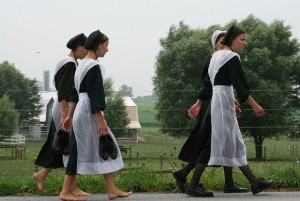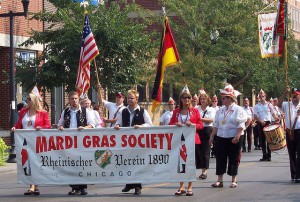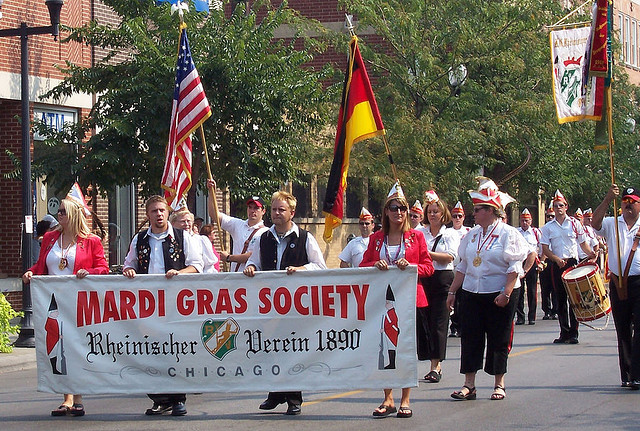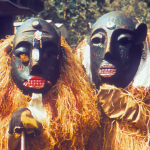When in America, have you ever eaten a hot dog at a baseball game? Or, have you ever watched the American Walt Disney classic Snow White and The Seven Dwarves? Some wildly popular “American” foods and past-times are actually, well, quite German. Although Germans were one of the largest and most industrious ethnic groups to immigrate to the USA, German culture seems to have all but disappeared due to Americanisation. How did this happen?
Germans were involved in the colonisation of the New World from the very beginning. However, while the first German settler arrived in Jamestown in 1608, it would take another 75 years until the first permanent German settlement, fittingly named Germantown, would be established. In the early phases of colonisation, it was mainly people of religious sects, such as the Mennonites, and paupers from the Palatinate region in Germany who arrived in the New World, fleeing persecution, poverty and military conscription. In order to pay for their trip, many of them ended up in working camps on arrival, as a form of indentured servitude, before moving on westwards.
The German settlers spread out over the entire Midwest and northern parts of the USA, a lot of them settling down in Pennsylvania. Germans acquired renown as successful farmers and keepers of livestock, but also branched out in other fields. Germans made history in America: the first Bible to be printed in the USA was German, the first millionaire in the New World, John Jacob Astor, made his fortune by trading fur and real estates, and John Peter Zenger, a printer and journalist, was hailed as the hero  defending the freedom of press against the colonial overlords in New York.
defending the freedom of press against the colonial overlords in New York.
Today, in some pockets of the United States, German culture and language continue to thrive. The Texas and Pennsylvanian German dialects are obvious examples of this perseverance of German heritage in the USA. In Pennsylvania, especially, the Old Order Amish and Mennonites still speak German in every-day life. Pennsylvanian German, or Deitsch, is a dialect that came into being when various south-western German dialects and the present-day dialect of the federal state of Rhineland-Palatinate were combined. Over the years, usage of the dialect has declined, although there is also a revivalist movement that tries to pass on this relic of a bygone era.
Through a forum for learners of German, I met Daniel Kauffman*, an American of German descent who grew up in Pennsylvania, the American state that initially attracted the most Palatinates. Although he never had a formal education in Deitsch, Daniel was able to pick it up from his father and his grandmother. After his grandmother passed away, however, possibilities to use the language became scarcer and scarcer. Today, he only uses it when travelling through Amish country. Listening to a recording of him speaking PA German, I can hear which area his ancestors came from, and I can understand all of it.
During the 1800s, immigration to the New World rose sharply. After the failed German Revolution of 1848, political enemies of the ruling elites and people hoping for societal change left the country in flocks. Towards the end of the century, emigration from Germany intensified. During that period, Hamburg gained importance as an emigration harbour.
Despite German expatriates’ separation from their homeland, German immigrants continued to practice German traditions and culture: establishing singing societies, German churches and synagogues all over the country. Due to the many adherents of sectarian denominations, religious life was fruitful. But this clinging to traditions also proved to be fatal when the First and  Second World War came around. Germans lobbied against America’s participation in World War II, and as a result, the non-German population grew wary of the German Americans. Many were accused of spying on the USA or endorsing the German war effort. A special census listing only German Americans was made, and more than 4,000 of them were imprisoned. German Americans faced discrimination and persecution from vigilante mobs.
Second World War came around. Germans lobbied against America’s participation in World War II, and as a result, the non-German population grew wary of the German Americans. Many were accused of spying on the USA or endorsing the German war effort. A special census listing only German Americans was made, and more than 4,000 of them were imprisoned. German Americans faced discrimination and persecution from vigilante mobs.
The German American community reacted with resignation to this stigma. German names were anglicised, the usage of German in everyday speech was limited, and German traditions were relinquished. Within a couple of decades, German Americans had assimilated so well that they went mostly unnoticed, which was in contrast to Italian and Irish Americans. Post-war German-American relations were focussing on the declared enemy, the Soviet Union, and reunification. The stigma only faded away slowly. Real efforts to improve the relations between the two peoples was only made in the early 1980s under the Reagan Administration, but it wasn’t until 2010 when a congressional caucus was formed for German Americans.
When the 2000 census was called, more than 42 million Americans claimed German or partially German ancestry, making up about 15 percent of the USA’s 282 million inhabitants and dwarfing any other ethnic background, with descendants of Irish and African Americans making up 11 and 9 percent respectively.
To Daniel, German culture in the USA manifests most where it has been amalgamated into American culture. Almost every American sends their child off to kindergarten. American Christians, Catholics, and, even, unreligious folks go on Easter egg hunts in spring or make gingerbread houses and gather under a Christmas tree in winter. One example that is more specific to Pennsylvania is the Butzemann, or Butz, which is a German bogeyman written in common folklore that scares kids into behaving. German cultural societies, such as the Delaware Sängerbund (singing society), continue to exist, and, in autumn, many American universities, restaurants, and festival grounds have their own Oktoberfest.
In the end, however, Daniel felt that he was slowly losing his dialect in America, so he packed up his things and went on a sojourn to reconnect with his ancestral roots. He is now living in Austria where he studies German. His studies are funded, in part, by a grant he received from one of the last remaining vestiges of German culture in America: Sängerbund. In less direct ways, however, German influence is apparent in many areas of American culture. Although most Americans may assume that their sausages and hamburgers from 7-11 are an American invention or that some of their beloved tales and children’s stories were from the genius of Walt Disney, German culture created part of the foundation for American cuisine, folklore, and traditions just as the Italian pizza at Domino’s and the Mexican burrito at Chipotle perpetuate the melting pot of American life. In this fragmented way, German culture and Daniel’s heritage live on.
By Michael Schätzlein
Image Credit:
Picture 1: Ted Knudsen licensed under CC BY-NC-ND 2.0
Picture 2: spablab licensed under
CC BY 2.0
* Names were changed to preserve anonymity.










